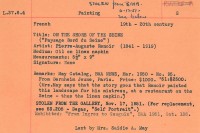 A court has ruled that the Renoir landscape that went on sale for $100,000 last year after its owner claimed to have bought it for $7 at a West Virginia flea market belongs to the Baltimore Museum of Art from which it was stolen in 1951. The federal court in Alexandria, Virginia, agreed with the museum’s argument that established law holds “a thief cannot pass title to stolen goods even to an innocent purchaser,” and that therefore the would-be seller, once known as Renoir Girl but now identified as Marcia Fuqua, cannot hold title no matter how she acquired the painting.
A court has ruled that the Renoir landscape that went on sale for $100,000 last year after its owner claimed to have bought it for $7 at a West Virginia flea market belongs to the Baltimore Museum of Art from which it was stolen in 1951. The federal court in Alexandria, Virginia, agreed with the museum’s argument that established law holds “a thief cannot pass title to stolen goods even to an innocent purchaser,” and that therefore the would-be seller, once known as Renoir Girl but now identified as Marcia Fuqua, cannot hold title no matter how she acquired the painting.
According to Fuqua, she found Paysage Bords de Seine in a box along with a Paul Bunyan doll and a plastic cow in 2009 at the Harpers Ferry Flea Market and bought the whole box for $7. Three years later in July of 2012, she brought the painting to the Potomack Company auction house in Arlington, Virginia. Apparently her mother had told her to have it appraised and the gilded wooden frame had a plaque with Renoir’s name and dates on it, so Fuqua wanted to find out if it really was a work by the Impressionist master. The auction company researched the work and determined it was authentic, that it had been sold in 1926 by the Bernheim-Jeune gallery in Paris to Baltimore lawyer and art collector Herbert L. May.
 There the trail appeared to end, but intrepid Washington Post reporter Ian Shapira dug deeper. He had the idea to look through the papers of Saidie Adler May, Herbert May’s wife at the time of the purchase (they were separated in 1924 and divorced in 1927) and a great collector in her own right who donated her art and personal archive to the Baltimore Museum of Art. Shapira found a note in her correspondence files recording the loan of Renoir’s Paysage Bords de Seine to the museum in 1937. There was a loan registration number on the record, and when museum director Doreen Bolger looked it up, she found an index card describing the history of the painting, its purchase and its theft from the museum in November of 1951. Further research found the original police report of the theft.
There the trail appeared to end, but intrepid Washington Post reporter Ian Shapira dug deeper. He had the idea to look through the papers of Saidie Adler May, Herbert May’s wife at the time of the purchase (they were separated in 1924 and divorced in 1927) and a great collector in her own right who donated her art and personal archive to the Baltimore Museum of Art. Shapira found a note in her correspondence files recording the loan of Renoir’s Paysage Bords de Seine to the museum in 1937. There was a loan registration number on the record, and when museum director Doreen Bolger looked it up, she found an index card describing the history of the painting, its purchase and its theft from the museum in November of 1951. Further research found the original police report of the theft.
The museum alerted Potomack Company and three days before the auction was supposed to take place, the painting was withdrawn from sale. The FBI seized the painting and asked the federal court to determine who the legal owner was. The painting had been insured for $2,500 when it was stolen, and the insurance company did pay the museum for the loss so technically Fireman’s Fund Insurance would own title, but it gave up its claim. The auction house also took itself out of the running. Fuqua and the Baltimore Museum of Art were the only parties left.
Fuqua’s argument was that the museum’s documentation of the theft hadn’t been properly authenticated, but the court didn’t buy it. Fuqua now has 30 days to file an appeal of the ruling, but the decision was very clear cut and it’s very unlikely to be reversed. Besides, Fuqua may find it wise to let this whole thing go, because her flea market story hasn’t exactly stood up to scrutiny.
[A] number of people who know Fuqua have cast doubt on her flea market story, including her brother. Some family acquaintances told The Post that they remember seeing the Renoir in the 1980s and 1990s at the Fairfax County home of her mother, Marcia Fouquet, who attended art college in Baltimore at the time of the painting’s theft in 1951. (The mother passed away five months ago at the age of 85.) […]
Matt Fuqua, Martha’s brother, who attended the hearing, was elated by the judge’s ruling and stood outside the courthouse before a bank of television cameras, giving interviews.
Before she died, his mother had urged Martha to return to the painting to the BMA, he said. “My mother wanted this.”
That’s like the third version of Matt’s story. The whole family has issues.
Anyway, the BMA is delighted by the outcome of the case and looking forward to the return of their prodigal Renoir. They’ll take possession after the 30-day appeal window closes. It will be examined by conservators first and then the museum plans to exhibit it in late March in a special installation.
This is a strange story. You noted that the auction company researched the work and determined it was authentic, that it had been sold in 1926 by the Bernheim-Jeune gallery in Paris to Baltimore lawyer and art collector Herbert May. You also note that Mrs May was a great collector in her own right who donated her art etc to the Baltimore Museum of Art. A note in her correspondence files recorded the loan of Renoir’s Paysage Bords de Seine to the museum in 1937.
Loaned to the museum in 1937, stolen in 1951, found in 2009, identified in 2012 and now returned to the museum! It sounds as if Mrs May’s grandchildren should recall the loan.
Saidie May left all of her art to the BMA, so actually the museum is her legitimate heir. She died six months before the theft and although the estate was still in probate at the time when the painting was stolen, the legal consensus is the museum owned the little Renoir outright.
Do I detect the influence of Antiques Roadshow in the Renoir Girl’s story of how she came by the painting?
It does seem a little pat in hindsight.
All we need to know now is who nicked it – not Renoir Girl, she’d have been a bit young; possibly her mother, but no real evidence. It will make a great heist movie some day.
There are many paintings, art objects, which were stolen to their legitimate owners in US Collections, like the case of a private collection in Washington DC, from a former Ambassador to Moscow. Most or all of the collection belonged before the revolution to collectos such as prince Felix Yussupov, the Romanov dynasty, countess Betshy Shuvalov and others. The US Courts refuses to recognize to their heirs their legitimate rights, this and other cases are similar to those related to confiscations of the Nazi regime in Germany, which were handed over recently and years ago to their real owners.
Marcia Fuqua
Marcia Fouquet
Matt Fuqua
Martha Fuqua
Marcia Fouquet
A series of similar and confusing names!
One wonders how the painting made the transition from the thief to the mother, Marcia Fouquet, an art student in Baltimore at the time???? I wonder if the daughter, Marcia/Martha Fuqua, knew it was stolen. There’s no question that she did know that she didn’t buy it at a flea market!